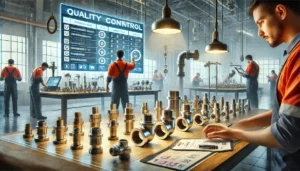Like many other mechanical objects, valves can pose efficiency, security, and reliability issues which can ultimately impede any industrial process. This is why engineers and maintenance experts must have a plan for every conceivable problem, which in this case are the common issues of the valve and their valves.
1. Leakage
At times, an entire system’s valve can become useless due to a leakage. Usually associated with the wear of packing, stem, and seat, these parts can become degraded with time leading to uncontrolled gasses or fluids escaping in a form of a leak. Not only resulting in the system average dropping, but at times could prove to be life-threatening depending on the chemical that is escaping the system.
Solution: The only realistic way to mitigate leakage is by severe focus on conducting proper maintenance and inspections regularly. There is a strong possibility that by replacing packing, seat, and seal to a new one, the majority of leaks will be reduced. On the other hand, if none of these solutions were able to resolve the valve meltdown, then a valve replacement must be conducted.
2. Blockage
An obstructed valve is too common to overlook. Blockages usually happen when gunk, dirt, and other foreign particles accumulate and get trapped within the valve making it impossible to operate. In dire situations, this could lead to an increase in pressure, drop in flow rates, and most importantly complete breakdown of the valve.
Solution: Ensuring fluid or gas to be conveyed through the valve is not contaminated in any manner is a must. Adopting the right filtering components upstream will help keep debris out of the valve. Regularly cleaning and inspecting the valve internals will allow for improved flow and performance optimization.
3. Cavitation
Due to a drop in pressure of the fluid flowing through the valve below its vapor pressure, vapor bubbles form which leads to cavitation. The bubbles collapse as pressure recovers, resulting in shock waves that erode valve components. This type of damage impacts the overall efficiency and reduces the lifespan of the valve.
Solution: To avoid cavitation, it is important to design the system so that the pressure is maintained above the vapor pressure of the fluid. Employing the right type of valves that are designed to operate in high cavitation conditions, such as anti-cavitation trims, is also beneficial. Using several stages of pressure drop within the valve helps to deal with pressure changes more evenly, thus eliminating the possibility of cavitation.
4. Erosion
Erosion takes place when liquid or gas flowing through the valve comes with abrasive particles which gradually wear away the valve components over time. The additional wear of the components leads to greater clearances and loss of effective sealing of the valve leading to inaccurate flow control.
Solution: To maintain effective performance in highly abrasive situations, it is important to choose materials for valve components with both high hardness and erosion resistance. These qualities can be mitigated by using flow conditioning devices positioned upstream to control the velocity of abrasive particles so they have less erosive impact. It is also important to perform monitoring of valve condition regularly to ensure that eroded parts get replaced in a timely manner.
5. Corrosion
Corrosion is the deterioration of valve materials caused by chemical interactions with the fluid or the external environment. It can result in rusting, pitting and weakening of the valve structure which can lead to leaks or even worse, a catastrophic failure of the valve.
Solution: Proper material selection is very vital; using stainless steel or protective coatings will prevent corrosion and enhance valve longevity. Abrasive environments may necessitate the use of valves made from exotic alloys, or non-metallic materials. Inspections for early signs of corrosion can result in maintenance or replacement works so that these problems do not develop further down the line.
6. Sticking or Seizing
Debris, corrosion, and lack of lubrication can result in valves becoming sticky or seizing. This will result in the valve not opening or closing effectively, hence disrupting process control and posing safety concerns.
Solution: Regular cleaning to remove debris and applying appropriate lubricants to moving parts can prevent sticking. In corrosive environments, selecting suitable materials and protective measures is essential. If a valve becomes seized, it may require disassembly for thorough cleaning or component replacement.
7. Failed Actuator
The Actuator Mechanism is the one that rotates the valve into the desired position. It fails because of electrical malfunction, tortured pneumatic supply, or due to mechanical failure of the actuator itself.
Solution: Always test and properly calibrate the actuators to know that they are doing their job as expected. Electrical cabling, pneumatic supply pressure, and a few mechanical parts should be checked as well. Actuators out of order should be changed or repaired. That’s how the reliability of the system is preserved.
8. Improperly Sized Valve
Any valve that is improperly sized for its application always results in control problems, increased wear, and wastes energy. There is a case where an oversized valve operates mostly in a nearly closed position, creating erosion and noise. The opposite problem occurs with an undersized valve where insufficient flow is achieved.
How To Solve And Prevent Problems Of Valves: Solutions For Controlled Noise, Vibration, And Calibration Problems.
In order to prevent problems with noise and vibration, I assume appropriate valves need to be used and sized correctly from the beginning. This might mean figuring out the flow coefficients that are required or using appropriate software or consulting with manufacturers to select an appropriately sized valve.
9. Noise And Vibration Problems
Excessive vibration and noise during the operation of valves are caused by high velocity flow, mechanical issues, or cavitation. These problems should subside whichever the case may be troubling to your ears or not as they can be a sign of an issue with the possibility of causing valve damage.
Solution: Identifying the root cause of problems and minimizing them ought to be the appropriate strategy. Doing so might involve system redesigning to utilize lower flow velocities, anti-cavitation measures, and ensuring that all the components are fixed properly. In some instances, adding vibration and coupled with noise attenuation might be helpful.
10. Vibration Measurement, Positioning, And Calibration Problems
Controlled flow rate in a system results in changed efficiency and product quality if the valves are not calibrated accurately or if there is positioning error, which will affect the overall process.
Solution: In as much as traceable changes in airflow cause these issues, the problems described could have been avoided if the control valves and its positioners were calibrated on a regular basis.










